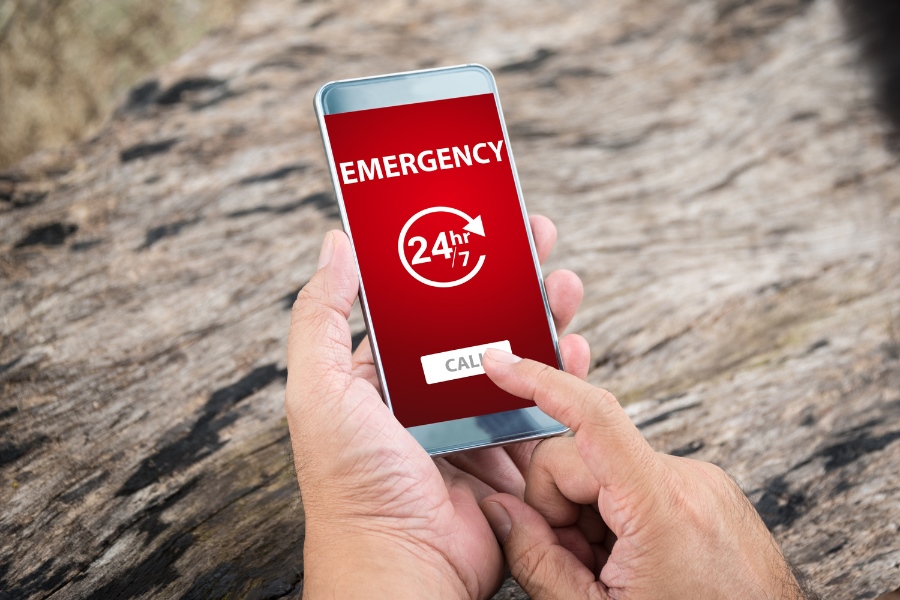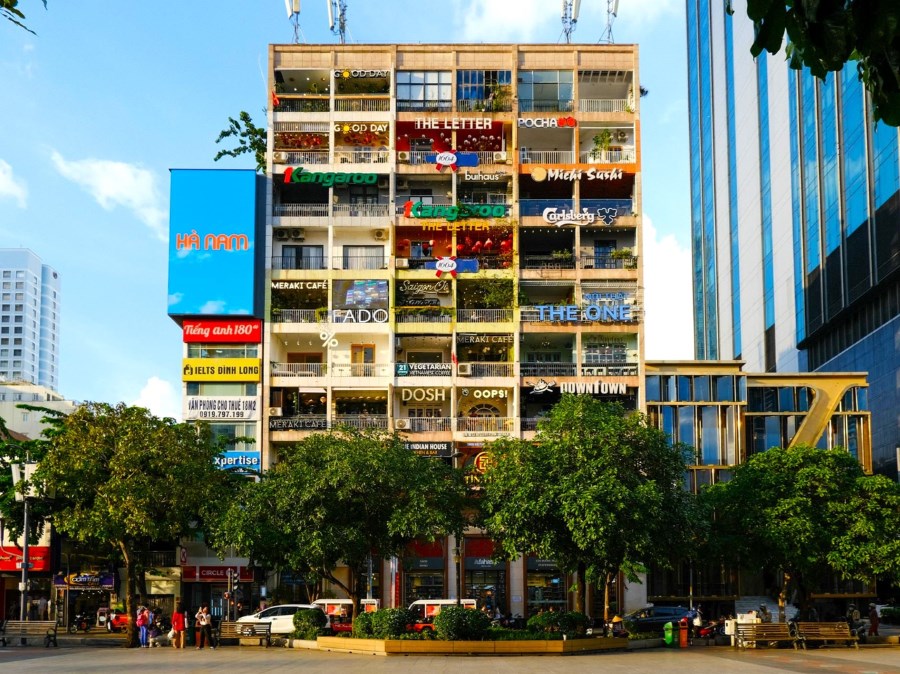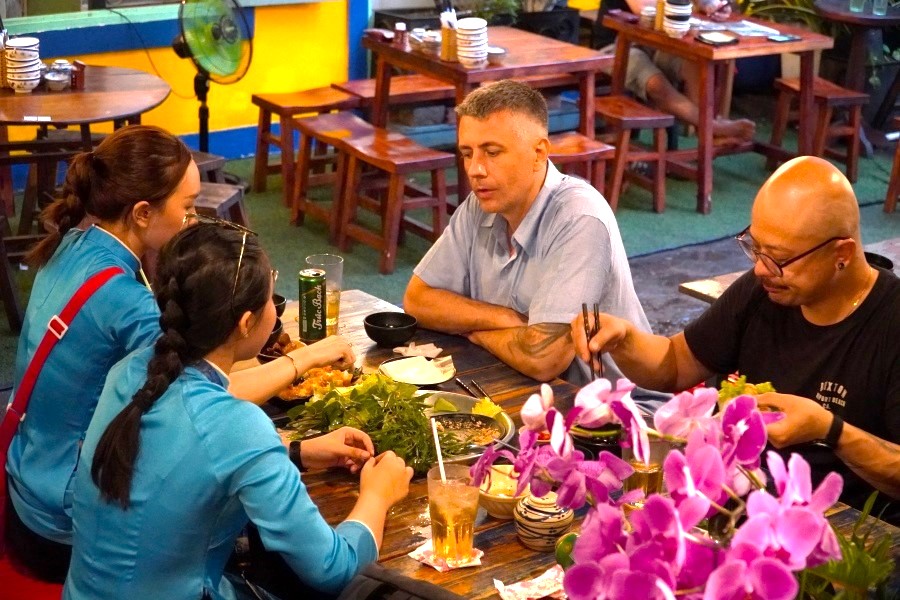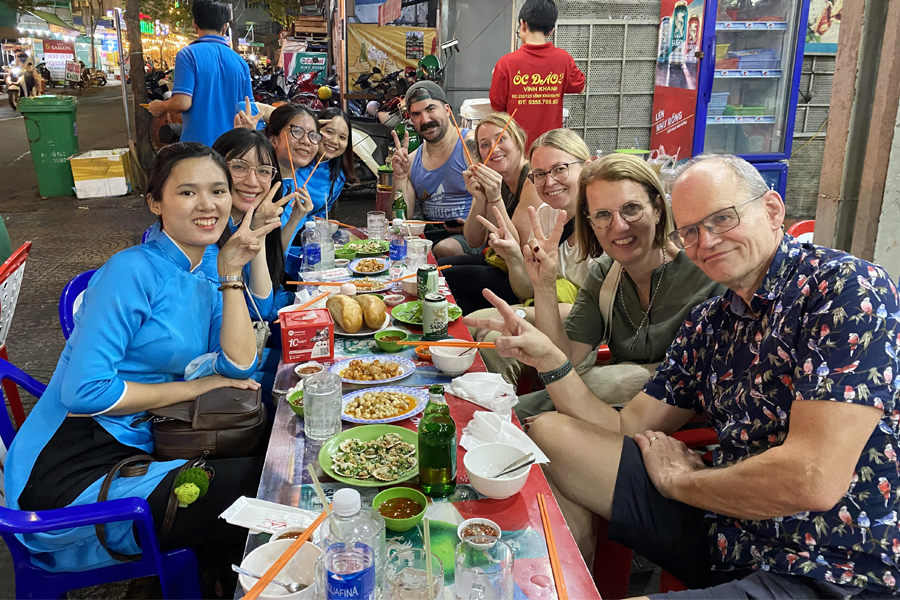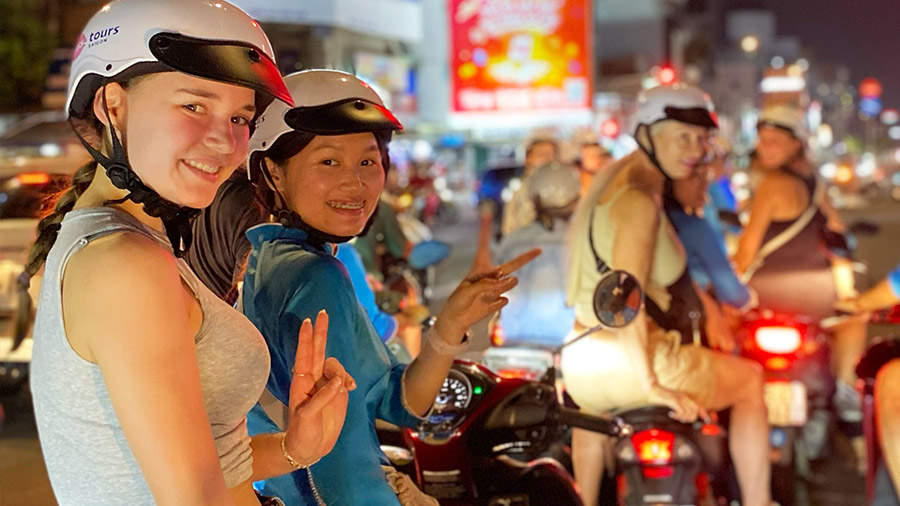Vietnam has a variety of transportation options visitors can use to see its stunning landscapes and vibrant cities. There are several methods to explore the nation, including traditional modes like railroads and motorcycles, as well as modern comforts like sleeper buses and boats.
In this guide, we’ll look at all the modes of transportation available, and help you pick the best option based on your needs and preferences!
How to Travel in Vietnam by Air?
Traveling in Vietnam by air has many advantages that make it an appealing option for tourists. For example, a Hanoi to Ho Chi Minh City flight takes around 2 hours, while the train takes almost 2 days. With a huge network of domestic airports and well-established carriers, air travel is both convenient and efficient, allowing travelers to cover long distances in a short period of time. Below is a list of useful information that will keep you well-informed when planning your trip around Vietnam by airplane.
Airlines
- Vietnam Airlines: Vietnam Airlines, the national flag airline, operates both local and international flights. They provide a diverse network of locations throughout Vietnam, including major cities such as Hanoi, Ho Chi Minh City, Da Nang, and more.
- Vietjet Air: Vietjet Air is a popular low-cost carrier in Vietnam, offering both local and international flights. They have low tickets and service numerous domestic locations, making them a popular alternative for budget tourists.
- Bamboo Airways: Bamboo Airways is a relatively new Vietnamese airline that operates both domestic and international flights. They specialize in providing a comfortable experience in a variety of locations throughout Vietnam.

Booking Flights
- Airline Websites: The majority of airlines have their own websites where you can directly book flights. Visit the airline’s website above to search for available flights, choose your trip dates, and book your reservation online.
- Online Travel Agencies (OTAs): Expedia, Booking.com, Kayak, and Skyscanner are among the online travel providers that aggregate flight possibilities from numerous airlines. These tools let you compare pricing, schedules, and airline options in one place.
- Mobile Apps: Many airlines and travel booking companies provide mobile apps that may be downloaded to your smartphone or tablet. These applications make it easy to look for and book flights while on the go.
- Travel Agents: If you prefer personal service or want assistance with complex itineraries, you can contact a travel agency. Vietnamese travel agents (such as Vietravel, Ben Thanh Tourist) have access to a variety of booking platforms and can assist you in finding the best airfare for your specific needs.
Tips for Air Travel in Vietnam
- Book Early: Vietnam can be a popular tourist destination, especially during peak travel seasons like Tet holiday, summer vacations. In order to secure your preferred flight times and prices, please book your tickets well in advance.
- Compare Prices: Compare costs from various airlines and booking platforms to discover the best deals. Prices might vary, so doing some research and comparing can help you save a ton of money.
- Check Baggage Allowance: Low-cost carriers in Vietnam sometimes impose tougher luggage limitations or charge an additional fee for checked baggage. To prevent additional airport fees or hassles, be sure your luggage doesn’t go over the size and weight requirements.
- Arrive Early: Arrive at the airport with enough time before your trip, especially during peak seasons. You should arrive two to three hours before takeoff time to ensure a stress-free check-in and security process, and give time for any unforeseen delays.
- Visa and Documents: If you need a visa to enter Vietnam, check the requirements before you fly, or read our Vietnam Visa Guide for more information. Make sure to check the expiration of your visa so that you don’t overstay. Also, bring any relevant travel documents, such as your passport, visa, and any other identification required for your trip. You will need your passport if you are traveling by plane within Vietnam, and you may sometimes be asked to show your visa as well.
- Local Transportation: Plan your transportation from the airport to your destination ahead of time. Taxis (Vinasun, Mai Linh), ride-hailing services (Grab, Gojek, Be, Xanh SM) or airport shuttles, and pre-arranged transportation are all viable options. Determine the most convenient and dependable solutions based on your arrival airport. Avoid any risk of being scammed by booking your transport in advance or using a ride-hailing app.
- Language Assistance: While English might be widely spoken in tourist areas, venturing off the beaten path can lead to some language barriers. To ensure smooth communication and deeper connections with locals, it’s helpful to equip yourself with some basic Vietnamese phrases. To assist you further, we have a comprehensive guide on Vietnamese Phrases for Travel that you can check out. Additionally, having a reliable Translation app Vietnamese English on your phone can be a lifesaver in various situations. Let’s delve into both these resources to ensure you’re well-prepared for your Vietnamese adventure!
How to Travel in Vietnam by Train?
Traveling by train in Vietnam takes longer than other modes of transportation, but I guarantee that it will take you through the country’s most stunning scenery!
Here’s some valuable information regarding the main lines, types of train classes, how to book your trip, and tips you might need when organizing your vacation through Vietnam by train.
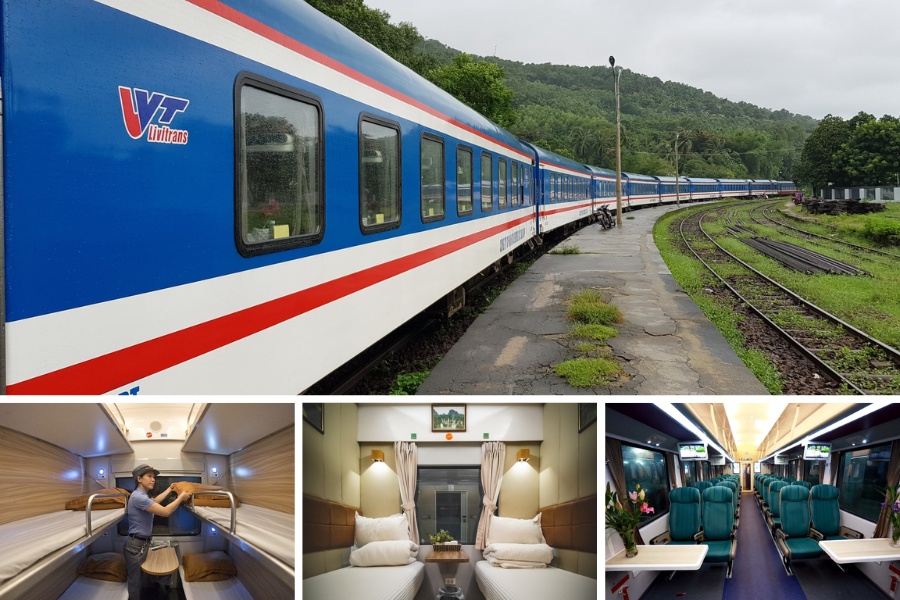
The Main Line
The Reunification Express connects Hanoi, the north’s capital, with Ho Chi Minh City (formerly Saigon) in the south. It covers around 1,726 kilometers (1,072 miles). This train line provides a thrilling tour across Vietnam’s various landscapes. Passengers are exposed to stunning vistas of rice terraces, verdant mountains, and captivating coastlines.
Several famous locations along the journey are popular with tourists. These include Hue, an old imperial city noted for its historical landmarks and cultural legacy; Da Nang, a bustling city with stunning beaches and a thriving culinary scene; and Nha Trang, a coastal resort town known for its immaculate beaches and water activities.The Reunification Express travels through small towns and villages, each with their own distinct beauty and attractions. These lesser-known sites provide an opportunity to discover true Vietnamese culture and local hospitality.
While train travel offers a unique perspective of Vietnam’s diverse landscapes, it’s important to consider all your options before deciding on the best way to get around. If you’re looking for a more comprehensive overview of transportation methods for your journey from Hanoi to Ho Chi Minh City, our article “What Is the Best Way To Travel From Hanoi to Ho Chi Minh City?” will provide you with a detailed comparison of various options, including flights, buses, and even motorbikes.
Types of Train Classes
- Hard Seat: Basic, non-reclining chairs and upright wooden seats. While it is the most cost-effective class and is typically encountered on shorter routes or local trains, it might be cramped and uncomfortable for prolonged trips.
- Soft Seat: This class provides comfy reclining seats with plenty of legroom. It is commonly seen on shorter routes and is a popular choice for day travel.
- Hard Sleeper: This class offers individual rooms with beds for overnight travel. The cabins usually accommodate six passengers, with six bunks per compartment (3 upper and 3 lower). It can get crowded, but is generally a more comfortable option.
- Soft Sleeper: These cabins typically accommodate four travelers, with four bunks to each compartment (2 upper and 2 lower). It is more spacious, with individual curtains and storage. This class offers more comfort and privacy for long-distance travel.
- VIP Class: Some trains, like the Livitrans Express or Lotus Train, have a VIP or premium class with additional facilities. This class may offer larger cabins with more comfortable mattresses, private restrooms, and other services.
Booking Your Tickets
- Online Booking: You can purchase tickets and check timetables on Vietnam Railways’ official website (https://dsvn.vn/) or some popular platforms for booking train tickets in Vietnam, including Baolau, 12go.asia.
- Travel Agencies: Local travel agents and tour operators frequently provide assistance in buying rail tickets. They can guide you through the booking procedure, recommend the best routes and classes, and handle the ticket transaction on your behalf.
- Train Stations: Train tickets can also be purchased directly at Vietnam’s train stations. Visit the ticket counter or designated ticket office at the station, provide your trip information, and pay in person. It is best to arrive early, especially during peak travel times, since popular routes might sell out quickly.
Tips for Train Travel in Vietnam
- Book in Advance: During peak travel seasons, it’s advisable to book your train tickets in advance to secure your preferred class, departure time, and route.
- Check the Train Schedule: Prior to your trip, double-check the train itinerary and departure times. Trains in Vietnam might occasionally encounter delays, so be aware of any changes to your scheduled departure.
- Bring Snacks and Water: Pack snacks, drinks, toiletries, and entertainment for longer trips. While some trains feature dining cars or onboard food services, it is always advisable to bring your own supplies.
- Dress Comfortably: Wear comfortable clothing and footwear because you may spend a long period on the train. Layers are advised because temperatures within the train can vary.
- Secure your Belongings: Keep your stuff safe throughout the journey. Lock your bags, and consider carrying a small bag or pouch to protect your valuables nearby.
- Seat61 – Vietnam: This is a comprehensive guide to train travel in Vietnam, including detailed route information and how to get from one0 place to another.
- Plan Your Trip According to the Weather: The best time to travel by train in Vietnam can depend on the weather and your desired destinations. Consider the various regions and their climates to ensure a comfortable and enjoyable train journey. For more guidance on choosing the ideal time for your Vietnam adventure, check out our article on “When is the best time to visit Vietnam“.
How to Travel in Vietnam by Bus?
Traveling by bus is a popular and convenient way to get around Vietnam, and personally, it is one of the more affordable and comfortable transportation methods that I prefer. Let me provide you with a guide on how to travel in Vietnam by bus, and the different types of buses available:
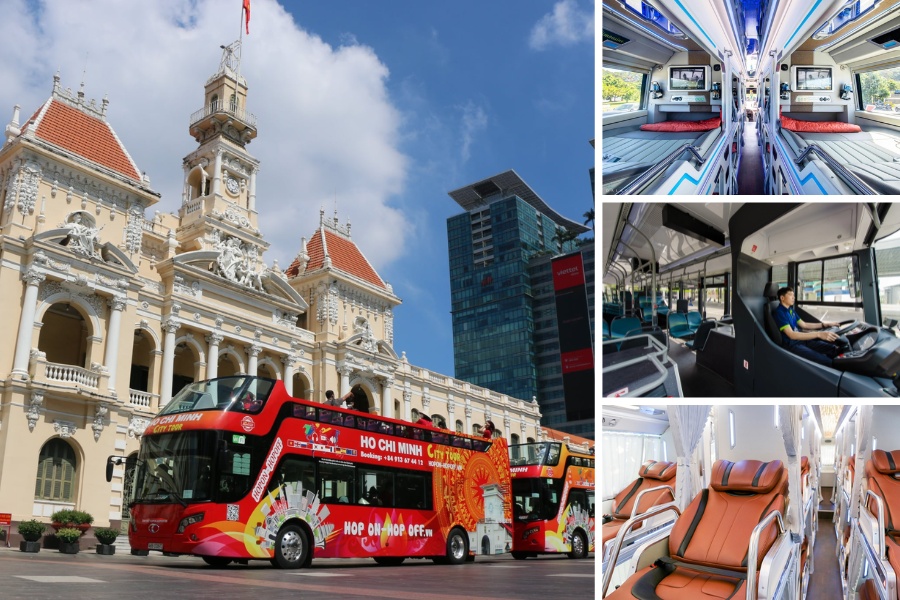
Types of Buses
- Open Tour Buses: Also known as hop-on-hop-off buses, are a popular choice for long-distance travel between major tourist destinations in Vietnam. These buses follow set routes and schedules, allowing you to get on and off at different stops along the way. They frequently have reclining seats, air conditioning, and make stops at famous tourist destinations along the way. Popular companies include Sinh Tourist, Hanh Cafe, and Phuong Trang.
- Sleeper Buses: Sleeper buses are intended for overnight trips and longer travels. They have reclining seats that may be turned into beds, allowing passengers to rest or sleep throughout the journey. Sleeper buses usually feature curtains for privacy and offer blankets or pillows for extra comfort. These buses are commonly used on routes like Hanoi to Sapa or between Ho Chi Minh City and the coastal regions.
- Minibuses or Minivans: Minibuses and minivans are frequently utilized for transportation between small towns or remote regions. They are smaller and can carry fewer passengers than standard buses. Minibuses frequently provide more direct routes and might be a speedier choice for entering locations not accessible by bigger buses.
- Local Buses: The cheaper but perhaps less comfortable alternative. These buses connect cities, towns, and villages throughout the country. They can be a more adventurous and engaging way to experience local life, but they may be more crowded and limited in facilities.
Booking Bus Tickets
- Online Booking: Many bus companies in Vietnam provide online booking options. To find bus timetables and availability, go to their official websites or trusted third-party travel websites, and then purchase your tickets online. Popular bus ticket booking platforms in Vietnam include Baolau, 12go.asia, and Vexere.
- Hotel or Guesthouse Front Desks: Many hotels and guesthouses in Vietnam can offer assistance in buying bus tickets. Inquire at the front desk or reception about the availability of this service. They can assist you with the booking process and make recommendations based on your trip itinerary.
- Bus Stations: If you want to book in person, go to the bus station directly. In major cities, there are central bus terminals with ticket counters from different carriers. Go to the proper counter for your selected route, provide your travel information, and pay in person.
- Travel Agencies: Local travel agents and tour operators frequently provide assistance in booking bus tickets. They are experts in itinerary planning and can assist you in selecting the best bus operator, route, and class for your needs. They can manage the booking procedure for you and may offer extra services like hotel transfers or travel packages.
Tips for Bus Travel
- Research Bus Operators: There are several bus operators in Vietnam, and the quality of service varies. Research bus companies, read reviews, and select reliable operators recognized for their safety and reliability.
- Purchase Tickets in Advance: To reserve your seat on long-distance or popular routes, book your bus tickets in advance, especially during peak travel times.
- Be Mindful of Baggage: Different bus operators have different luggage regulations and limits. Check the criteria ahead of time to prevent any complications or additional expenses.
- Dress Comfortably: Wear comfortable clothing and footwear because you may spend a long period on the bus. Layers are advised because temperatures can vary within the bus.
- Plan for Rest Stops: Longer bus rides frequently feature rest stations where you may stretch your legs, use the restroom, and have a bite to eat. Take advantage of these stops to refresh yourself along the journey.
- Bring Snacks and Water: Pack snacks, drinks, toiletries, and entertainment for longer trips, as the bus usually only provides small snacks and a bottle of water, so make sure you grab something to eat during the stops.
- Keep Valuables With You at All Times: Make sure to keep your vital documents, money, and valuables in a safe bag or backpack during the trip.
How to Travel in Vietnam by Taxi?
Unlike other transportation methods where you have to travel to their terminals or stations, taxis offer a handy door-to-door transportation choice, especially for those traveling with luggage, or are in locations not well served by public transportation. Taxis will pick you up from your location and drop you off at your preferred destination, saving you time and effort. Here is some useful information if traveling by taxi is your thing:
Types of Taxi
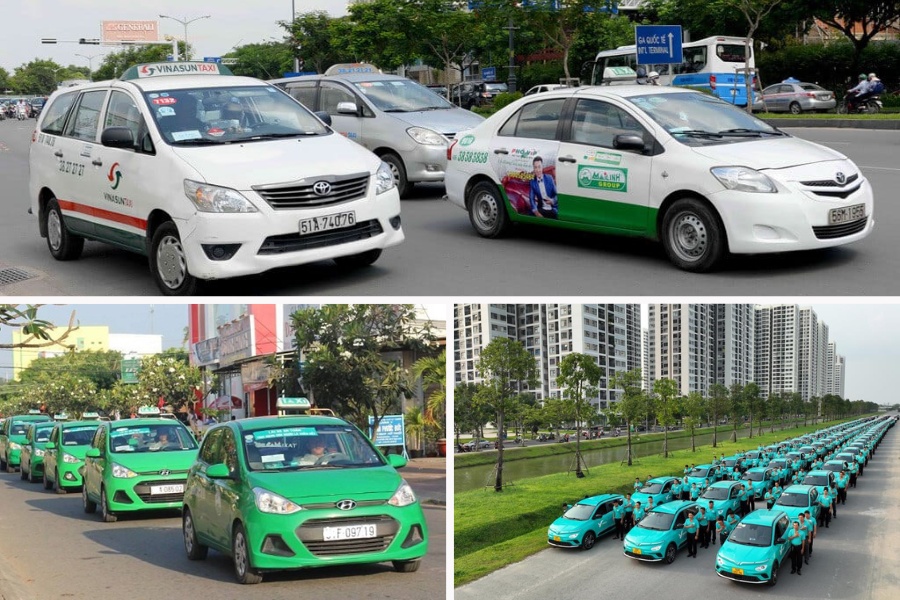
- Metered Taxis: Metered taxis are the most common type of taxi in Vietnam’s cities. These taxis use meters that determine the charge depending on the distance traveled and wait time. They are frequently painted in distinctive colors and include the taxi company’s name or symbol. The most reputable companies are Mailinh (green), Vinasun (white), and Xanh SM (blue).
- Ride-Hailing Services: Ride-hailing apps like Grab, Gojek, and Be are extensively accessible in Vietnam. These services allow you to order a taxi using a smartphone app, providing convenience and, in many cases, a fee estimate shown prior to your journey. You can track the driver’s position, pay using the app, and rate your experience.
- Motorbike Taxis (Xe Om): Motorbike taxis, also known as “xe om” in Vietnamese, are a popular way to travel short distances or navigate through congested traffic. These taxis are comprised of a motorcycle and a driver who will get you to your destination, but remember to negotiate the fare before beginning the ride, as they often do not have meters.
Finding Taxis
- Look for Taxi Stands: In busy areas or near transit hubs, taxi stands or lineups are common places where taxis await customers. Look for signs or markings identifying the taxi stand and get in line.
- Hail a Taxi on the Street: If you’re in a region where cabs are easily accessible, you can hail one on the street. Look for taxis passing by, and when you spot one, raise your hand to indicate to the driver that you need a ride. Once the taxi has stopped, tell the driver where you want to go and continue the trip.
- Use Ride-Hailing Apps: When you request a taxi using the app, it will display the estimated fare, driver information, and the location of the car. Wait for the taxi to arrive at your pickup location and confirm that the car and driver match the details on the app.
- Seek Assistance From Hotels or Restaurants: If you’re in a hotel or restaurant, the personnel can usually help you order a cab. Inform the receptionist or staff member of your location, and they will organize a cab for you. They may also offer you information on the expected fare, or any other relevant information.
Tips for Using Taxis in Vietnam
- Choose Reputable Taxi Companies: Stick to well-known and reputable taxi companies to ensure a safe and reliable experience (Mailinh, Vinasun and Xanh SM).
- Use Metered Taxis: Whenever possible, use metered cabs. Before you begin your travel, ensure that the meter is working correctly to ensure a fair and transparent fare computation.
- Negotiate Fares Upfront: Negotiate and settle on the fee before beginning the journey in taxis without meters or motorcycle taxis (xe om).
- Small Bills: Carry small denominations of Vietnamese Dong (VND) to avoid any issues with change or drivers claiming not to have any.
- Tipping: Not expected but appreciated for good service. Rounding up the fare or adding a small tip is a nice gesture.
- Rush Hour: Traffic can get very chaotic in major cities during peak hours. Allow extra travel time or consider alternative transport options like motorbikes if you’re in a hurry.
- Beware of scams: While taxis is generally safe, it’s important to be aware of potential scams, especially when it comes to negotiating fares or dealing with unlicensed drivers. For more information on how to protect yourself and ensure a worry-free trip, check out our comprehensive guide on “A Guide to Avoiding Scams in Vietnam 2024“.
How to Travel in Vietnam by Cyclo?
While cyclos are not a common means of transportation, they are a wonderful way to travel to your destination, enabling you to enjoy the views, sounds, and scents of the city at a slower speed. Here are some tips on how you can take a cyclo ride during your trip in Vietnam:
Why Take a Cyclo Ride
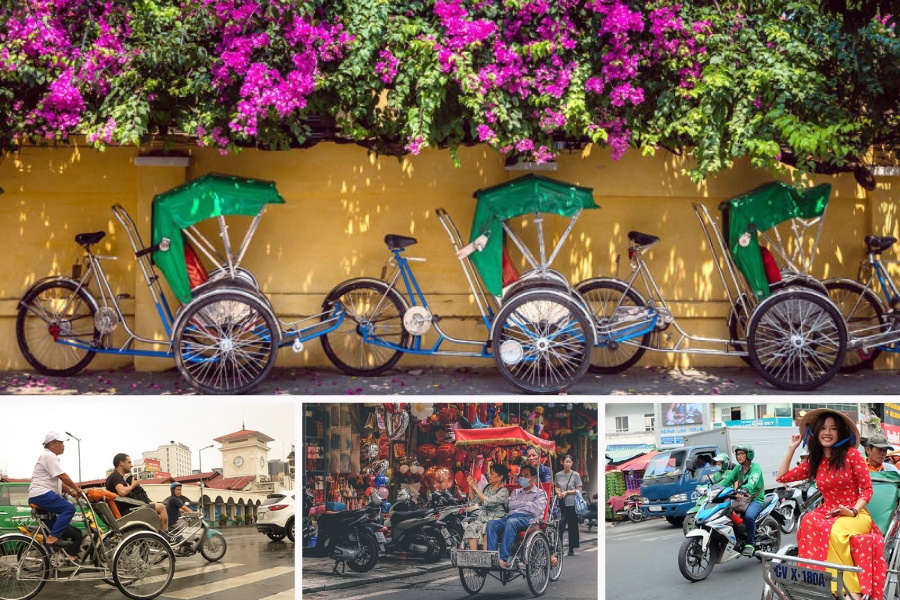
- A Touch of History and Culture: Cyclos have become an iconic symbol of Vietnamese life, offering a glimpse into the past and a traditional mode of transport.
- Slow and Scenic: Cyclos aren’t about getting somewhere fast. They’re about soaking in the atmosphere, enjoying the sights, and feeling the rhythm of the city at a relaxed pace.
- Environmentally Friendly: Cyclos are human-powered, making them an environmentally friendly means of transportation. If you want to reduce your carbon footprint when traveling, cycling might be a sustainable option.
- Perfect for Short Trips: Great for navigating bustling city centers, exploring narrow streets of the Old Quarter in Hanoi, or cruising around the heart of Saigon.
- Flexibility and Accessibility: Cyclos are small and flexible, making them perfect for traversing narrow streets, alleyways, and congested situations that would be difficult for bigger vehicles. They may transport you to locations that are not easily accessible by car or bus, allowing you to have a more thorough exploration of the city.
- Supporting Local Livelihoods: Using cyclos directly benefits the local economy and the livelihoods of cyclo drivers. Many cyclo drivers are elderly people who rely on it to maintain themselves and their families.
Where to Find Cyclos
- Old Quarter of Hanoi: The Old Quarter of Hanoi, with its small alleyways and lively marketplaces, is a favorite destination for cyclo rides. Cyclos are frequently seen parked around important sites like Hoan Kiem Lake or on well-known streets like Hang Gai and Hang Bac.
- Ho Chi Minh City (Saigon): Cyclos are regularly spotted on Ho Chi Minh City’s busy streets. They are frequently found around tourist destinations like Ben Thanh Market, the Notre Dame Cathedral, and prominent avenues like Dong Khoi and Nguyen Hue.
- Hue: Cyclo rides are a popular mode of transportation in Hue, which is noted for its historical attractions and Imperial Citadel. Cyclos may be seen around major landmarks like the Imperial City, Thien Mu Pagoda, and the Perfume River.
- Hoi An: Hoi An’s lovely old town, a UNESCO World Heritage Site, is pedestrian-friendly and ideal for cycling. Cyclos may be seen near the historic Japanese Covered Bridge, Tran Phu Street, and the Thu Bon River.
- Da Lat: Visitors to the scenic city of Da Lat, noted for its mild environment and gorgeous surroundings, may enjoy cyclo rides. Look for cyclos near Da Lat Market, Lam Vien Square, and Xuan Huong Lake.
- Tourist Areas: Cyclos are frequently seen in prominent tourist destinations, resorts, and coastal towns throughout Vietnam. These might include sites like Nha Trang, Da Nang, Sapa, and Phu Quoc Island.
Tips for Taking a Cyclo Ride
- Negotiate the Fare BEFORE: Remember to negotiate and agree on the fare upfront to avoid misunderstandings. Consider both the distance you’ll cover and the time you want.
- Haggling is OK: Don’t be afraid to bargain a bit, but be respectful with a friendly smile.
- Ensure Comfort and Safety: Cyclos are open-air vehicles, so dress properly. If it’s sunny, wear sunscreen and a hat; if it’s raining, bring an umbrella or raincoat.
- Secure Your Belongings: It’s best to keep small bags or valuables on you, rather than leave them in the open basket of the cyclo.
- Communicate Clearly: If you have any specific requests or instructions during the ride, communicate them clearly to the driver.
- Be Considerate of the Driver: Cyclos are pedal-powered, so be mindful of the weight in the carriage and be patient with the driver, especially on uphill sections.
- Relax and Enjoy: Cyclos are all about the slow-paced experience! Enjoy the view and as many photos as you want.
How to Travel in Vietnam by Motorbike?
Traveling by motorcycle in Vietnam may be an exciting and adventurous way to see the country. However, it is critical to assess certain criteria and make an informed selection based on your experience, comfort level, and safety concerns. Here’s a guide on how to travel in Vietnam by motorcycle, along with some issues to consider:
Should You Do It?
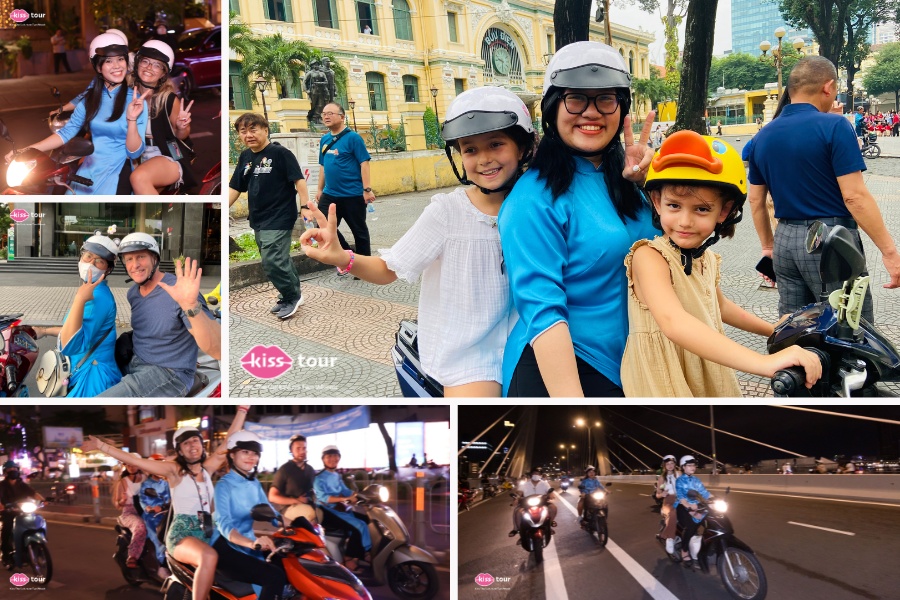
- Experience: Ideally, I would recommend that you have some motorbike experience before jumping on one in Vietnam, because unlike other countries, Vietnam’s traffic is “organized chaos” – which is another word for crazy.
- License: Legally, you would need an International Driver’s Permit (IDP) with a motorcycle endorsement AND a Vietnamese driving license to ride in Vietnam, which can take time to get.
- Confidence: You must have a high level of confidence, adaptability, and familiarity with some degree of ordered chaos on the road. But make sure that before you begin driving, you have spent some time observing and understanding the local traffic patterns, road laws, and driving etiquette.
Buying vs. Renting
- Short Trips: If you just have a few weeks or months to see Vietnam, renting a motorbike is a better option. Renting allows you to have a motorbike already available without having to buy and sell it later. Tigit Motorbikes, QT Motorbikes, and Flamingo Travel are among the most popular rental firms.
- Long Trips: If you’re going to be in Vietnam for a month or longer, purchasing a secondhand motorcycle (a Honda Win is a popular choice) and then reselling it is typically a better deal.
Essential Gear

- Helmet: A legal requirement in Vietnam, and crucial for safety. A high-quality, well-fitting helmet is the most essential piece of safety equipment for protecting your head in the event of an accident.
- Protective Clothing: Wear clothing that provides protection in case of a fall or slide, such as motorcycle-specific jackets, sturdy pants, and most importantly gloves for a tight grip and shield from debris and sunburn.
- Eye Protection: Wearing goggles or a helmet with a visor will protect your eyes from dust, debris, wind, and insects. Depending on the weather and visibility, choose between clear or tinted glasses.
- Rain Gear: Vietnam’s weather can be unpredictable, so bring appropriate rain gear. Invest in a high-quality rain jacket and pants to keep you dry during unexpected showers.
- First Aid Kit: It is recommended that you carry a basic first aid pack stocked with materials for minor injuries or emergencies. Include bandages, antiseptic wipes, pain relievers, and any personal prescriptions you may require.
How to Travel in Vietnam by Water?
Even though transportation by water is not fully developed yet, traveling by water in Vietnam can still be a unique and enjoyable way to explore the country’s stunning coastlines, rivers, and waterways. Here are the ways that you can travel in Vietnam using water transport:
Types of Water Transport
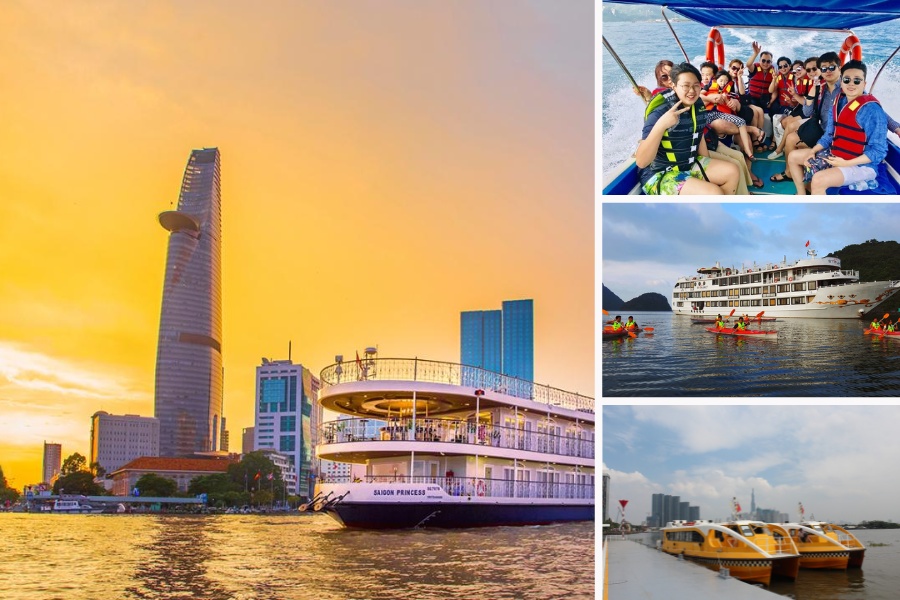
- Sightseeing Cruises and Tours: These range from short tours of urban waterways to multi-day cruises on majestic Halong Bay, for example. Cruises can vary from luxury cruises with all-inclusive facilities to smaller, more intimate cruises that focus on certain places or themes.
- Public Ferries: A functional and affordable way to travel between towns and cities on rivers or coastal routes. For example, ferries connect Ho Chi Minh City to Vung Tau or islands off the coast.
- Small Boats Hired Locally: In many areas, you can hire smaller boats with local boatmen for exploring mangroves, floating villages, or quieter parts of a coastline.
- Rowboats and Basket Boats: Add a touch of local flavor with short rides in traditional rowboats or unique round basket boats, especially in places like Hoi An.
- Speedboats: Speedboats offer a quick and easy alternative for customers wishing to save journey time. They are often utilized for transportation to and from locations like Phu Quoc Island and the Mekong Delta.
- Kayaks and Canoes: Renting a kayak or canoe in areas like Halong Bay and Ninh Binh allows you to explore caves, lagoons, and other natural formations, providing a more immersive view of Vietnam’s waterways.
Booking and Finding Water Travel
- Online Booking Platforms: Websites and applications such as Agoda, Booking.com, and Expedia frequently provide ferry, cruise, and speedboat alternatives. These platforms make it easy to compare pricing, read customer reviews, and make bookings.
- Travel Agencies and Hotels: They can provide information on schedules, prices, and availability. Easily arrange bookings for popular cruises on Halong Bay, the Mekong Delta, and sightseeing tours.
- Cruise Companies: Reputable companies offer different cruises catering to your budget and itinerary. Some popular options include Paradise Cruises for Halong Bay and Mekong Eyes for the Mekong Delta.
- Local Boat Owners: In many coastal towns and riverside areas, you can approach boat owners directly and negotiate a short trip to explore the surroundings.
- Ports and Terminals: Visit the ports or terminals in the area where you intend to begin your water adventure. This is especially beneficial for ferry services and small boats. You can ask the ticket counters or information desks for timetables, ticket pricing, and other relevant information.
Tips for Water Travel
- Pack Essentials: Bring the necessities for your water trip adventure. Consider essentials such as sunscreen, a hat, sunglasses, a lightweight jacket or raincoat, and bug repellant.
- Appropriate Clothing: Dress for comfort and potential splashes, depending on the type of boat.
- Safety: Be mindful of safety regulations on ferries and smaller boats. Always wear a life jacket if provided, and pay attention to the condition of the vessel and the safety instructions provided.
- Seasickness: If you’re prone to motion sickness, consider calmer river cruises rather than open ocean cruises, and have appropriate medication ready.
- Weather: Keep an eye on weather forecasts and be aware of any potential storms, rough seas, or adverse weather conditions that may affect water travel.
- Stay Hydrated: When cruising on the sea, it is easy to become dehydrated, especially during hot weather. Carry a refillable water bottle to stay hydrated on your journey.
- Enjoy the Experience: Water travel in Vietnam provides stunning vistas and unique experiences. Take the time to absorb the scenery, enjoy the ride, and capture special moments.
While exploring Vietnam’s waterways offers unique perspectives and experiences, Ho Chi Minh City boasts a wealth of attractions waiting to be discovered. If you’re wondering how to best spend your time in this vibrant metropolis, our comprehensive guide on What To Do In Ho Chi Minh City In 3 Days? will ensure you make the most of your urban adventure. From historical landmarks to bustling markets and mouthwatering cuisine, there’s something for everyone in this dynamic city. Let’s dive into our itinerary and discover the hidden gems that await you!


